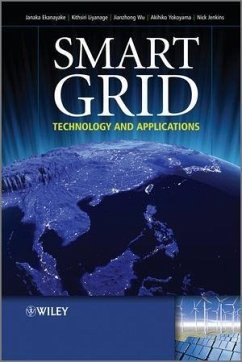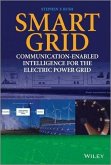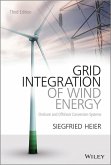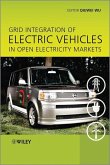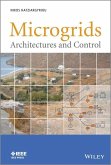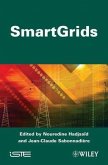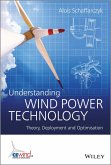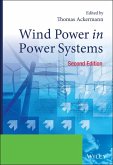Smart Grid (eBook, ePUB)
Technology and Applications


Alle Infos zum eBook verschenken

Smart Grid (eBook, ePUB)
Technology and Applications
- Format: ePub
- Merkliste
- Auf die Merkliste
- Bewerten Bewerten
- Teilen
- Produkt teilen
- Produkterinnerung
- Produkterinnerung

Hier können Sie sich einloggen

Bitte loggen Sie sich zunächst in Ihr Kundenkonto ein oder registrieren Sie sich bei bücher.de, um das eBook-Abo tolino select nutzen zu können.
Electric power systems worldwide face radical transformation with the need to decarbonise electricity supply, replace ageing assets and harness new information and communication technologies (ICT). The Smart Grid uses advanced ICT to control next generation power systems reliably and efficiently. This authoritative guide demonstrates the importance of the Smart Grid and shows how ICT will extend beyond transmission voltages to distribution networks and customer-level operation through Smart Meters and Smart Homes. Smart Grid Technology and Applications: * Clearly unravels the evolving Smart…mehr
- Geräte: eReader
- mit Kopierschutz
- eBook Hilfe
- Größe: 10.85MB
![Smart Grid (eBook, ePUB) Smart Grid (eBook, ePUB)]() Stephen F. BushSmart Grid (eBook, ePUB)84,99 €
Stephen F. BushSmart Grid (eBook, ePUB)84,99 €![Grid Integration of Wind Energy (eBook, ePUB) Grid Integration of Wind Energy (eBook, ePUB)]() Siegfried HeierGrid Integration of Wind Energy (eBook, ePUB)94,99 €
Siegfried HeierGrid Integration of Wind Energy (eBook, ePUB)94,99 €![Grid Integration of Electric Vehicles in Open Electricity Markets (eBook, ePUB) Grid Integration of Electric Vehicles in Open Electricity Markets (eBook, ePUB)]() Qiuwei WuGrid Integration of Electric Vehicles in Open Electricity Markets (eBook, ePUB)98,99 €
Qiuwei WuGrid Integration of Electric Vehicles in Open Electricity Markets (eBook, ePUB)98,99 €![Microgrids (eBook, ePUB) Microgrids (eBook, ePUB)]() Microgrids (eBook, ePUB)88,99 €
Microgrids (eBook, ePUB)88,99 €![Smart Grids (eBook, ePUB) Smart Grids (eBook, ePUB)]() Smart Grids (eBook, ePUB)140,99 €
Smart Grids (eBook, ePUB)140,99 €![Understanding Wind Power Technology (eBook, ePUB) Understanding Wind Power Technology (eBook, ePUB)]() Understanding Wind Power Technology (eBook, ePUB)68,99 €
Understanding Wind Power Technology (eBook, ePUB)68,99 €![Wind Power in Power Systems (eBook, ePUB) Wind Power in Power Systems (eBook, ePUB)]() Wind Power in Power Systems (eBook, ePUB)130,99 €
Wind Power in Power Systems (eBook, ePUB)130,99 €-
-
-
Dieser Download kann aus rechtlichen Gründen nur mit Rechnungsadresse in A, B, BG, CY, CZ, D, DK, EW, E, FIN, F, GR, HR, H, IRL, I, LT, L, LR, M, NL, PL, P, R, S, SLO, SK ausgeliefert werden.
- Produktdetails
- Verlag: John Wiley & Sons
- Seitenzahl: 320
- Erscheinungstermin: 23. Februar 2012
- Englisch
- ISBN-13: 9781119969099
- Artikelnr.: 37358510
- Verlag: John Wiley & Sons
- Seitenzahl: 320
- Erscheinungstermin: 23. Februar 2012
- Englisch
- ISBN-13: 9781119969099
- Artikelnr.: 37358510
- Herstellerkennzeichnung Die Herstellerinformationen sind derzeit nicht verfügbar.
Preface xiii
Acknowledgements xv
List of abbreviations xvii
1 The Smart Grid 1
1.1 Introduction 1
1.2 Why implement the Smart Grid now? 2
1.2.1 Ageing assets and lack of circuit capacity 2
1.2.2 Thermal constraints 2
1.2.3 Operational constraints 3
1.2.4 Security of supply 3
1.2.5 National initiatives 4
1.3 What is the Smart Grid? 6
1.4 Early Smart Grid initiatives 7
1.4.1 Active distribution networks 7
1.4.2 Virtual power plant 9
1.4.3 Other initiatives and demonstrations 9
1.5 Overview of the technologies required for the Smart Grid 12
References 14
Part I Information and Communication Technologies
2 Data communication 19
2.1 Introduction 19
2.2 Dedicated and shared communication channels 19
2.3 Switching techniques 23
2.3.1 Circuit switching 24
2.3.2 Message switching 24
2.3.3 Packet switching 24
2.4 Communication channels 25
2.4.1 Wired communication 27
2.4.2 Optical fibre 29
2.4.3 Radio communication 33
2.4.4 Cellular mobile communication 34
2.4.5 Satellite communication 34
2.5 Layered architecture and protocols 35
2.5.1 The ISO/OSI model 36
2.5.2 TCP/IP 40
References 43
3 Communication technologies for the Smart Grid 45
3.1 Introduction 45
3.2 Communication technologies 46
3.2.1 IEEE 802 series 46
3.2.2 Mobile communications 59
3.2.3 Multi protocol label switching 60
3.2.4 Power line communication 62
3.3 Standards for information exchange 62
3.3.1 Standards for smart metering 62
3.3.2 Modbus 63
3.3.3 DNP 3 64
3.3.4 IEC 61850 65
References 66
4 Information security for the Smart Grid 69
4.1 Introduction 69
4.2 Encryption and decryption 70
4.2.1 Symmetric key encryption 71
4.2.2 Public key encryption 75
4.3 Authentication 76
4.3.1 Authentication based on shared secret key 76
4.3.2 Authentication based on key distribution centre 77
4.4 Digital signatures 77
4.4.1 Secret key signature 77
4.4.2 Public key signature 77
4.4.3 Message digest 78
4.5 Cyber security standards 79
4.5.1 IEEE 1686: IEEE standard for substation intelligent electronic
devices (IEDs) cyber security capabilities 79
4.5.2 IEC 62351: Power systems management and associated information
exchange - data and communications security 80
References 80
Part II Sensing, Measurement, Control and Automation Technologies
5 Smart metering and demand-side integration 83
5.1 Introduction 83
5.2 Smart metering 84
5.2.1 Evolution of electricity metering 84
5.2.2 Key components of smart metering 86
5.3 Smart meters: An overview of the hardware used 86
5.3.1 Signal acquisition 87
5.3.2 Signal conditioning 89
5.3.3 Analogue to digital conversion 90
5.3.4 Computation 94
5.3.5 Input/output 95
5.3.6 Communication 96
5.4 Communications infrastructure and protocols for smart metering 96
5.4.1 Home-area network 96
5.4.2 Neighbourhood area network 97
5.4.3 Data concentrator 98
5.4.4 Meter data management system 98
5.4.5 Protocols for communications 98
5.5 Demand-side integration 99
5.5.1 Services provided by DSI 100
5.5.2 Implementations of DSI 104
5.5.3 Hardware support to DSI implementations 107
5.5.4 Flexibility delivered by prosumers from the demand side 109
5.5.5 System support from DSI 110
References 111
6 Distribution automation equipment 113
6.1 Introduction 113
6.2 Substation automation equipment 114
6.2.1 Current transformers 116
6.2.2 Voltage transformers 121
6.2.3 Intelligent electronic devices 121
6.2.4 Bay controller 124
6.2.5 Remote terminal units 124
6.3 Faults in the distribution system 125
6.3.1 Components for fault isolation and restoration 127
6.3.2 Fault location, isolation and restoration 132
6.4 Voltage regulation 135
References 139
7 Distribution management systems 141
7.1 Introduction 141
7.2 Data sources and associated external systems 142
7.2.1 SCADA 143
7.2.2 Customer information system 144
7.3 Modelling and analysis tools 144
7.3.1 Distribution system modelling 144
7.3.2 Topology analysis 149
7.3.3 Load forecasting 151
7.3.4 Power flow analysis 152
7.3.5 Fault calculations 156
7.3.6 State estimation 160
7.3.7 Other analysis tools 165
7.4 Applications 165
7.4.1 System monitoring 165
7.4.2 System operation 166
7.4.3 System management 168
7.4.4 Outage management system (OMS) 168
References 171
8 Transmission system operation 173
8.1 Introduction 173
8.2 Data sources 173
8.2.1 IEDs and SCADA 173
8.2.2 Phasor measurement units 174
8.3 Energy management systems 177
8.4 Wide area applications 179
8.4.1 On-line transient stability controller 181
8.4.2 Pole-slipping preventive controller 181
8.5 Visualisation techniques 183
8.5.1 Visual 2-D presentation 184
8.5.2 Visual 3-D presentation 185
References 186
Part III Power Electronics and Energy Storage
9 Power electronic converters 189
9.1 Introduction 189
9.2 Current source converters 191
9.3 Voltage source converters 195
9.3.1 VSCs for low and medium power applications 196
9.3.2 VSC for medium and high power applications 199
References 203
10 Power electronics in the Smart Grid 205
10.1 Introduction 205
10.2 Renewable energy generation 206
10.2.1 Photovoltaic systems 206
10.2.2 Wind, hydro and tidal energy systems 209
10.3 Fault current limiting 213
10.4 Shunt compensation 217
10.4.1 D-STATCOM 218
10.4.2 Active filtering 224
10.4.3 Shunt compensator with energy storage 224
10.5 Series compensation 228
References 231
11 Power electronics for bulk power flows 233
11.1 Introduction 233
11.2 FACTS 234
11.2.1 Reactive power compensation 235
11.2.2 Series compensation 241
11.2.3 Thyristor-controlled phase shifting transformer 243
11.2.4 Unified power flow controller 245
11.2.5 Interline power flow controller 246
11.3 HVDC 248
11.3.1 Current source converters 249
11.3.2 Voltage source converters 253
11.3.3 Multi-terminal HVDC 256
References 257
12 Energy storage 259
12.1 Introduction 259
12.2 Energy storage technologies 263
12.2.1 Batteries 263
12.2.2 Flow battery 264
12.2.3 Fuel cell and hydrogen electrolyser 266
12.2.4 Flywheels 267
12.2.5 Superconducting magnetic energy storage systems 270
12.2.6 Supercapacitors 270
12.3 Case study 1: Energy storage for wind power 271
12.4 Case study 2: Agent-based control of electrical vehicle battery
charging 273
References 277
Index 279
Preface xiii
Acknowledgements xv
List of abbreviations xvii
1 The Smart Grid 1
1.1 Introduction 1
1.2 Why implement the Smart Grid now? 2
1.2.1 Ageing assets and lack of circuit capacity 2
1.2.2 Thermal constraints 2
1.2.3 Operational constraints 3
1.2.4 Security of supply 3
1.2.5 National initiatives 4
1.3 What is the Smart Grid? 6
1.4 Early Smart Grid initiatives 7
1.4.1 Active distribution networks 7
1.4.2 Virtual power plant 9
1.4.3 Other initiatives and demonstrations 9
1.5 Overview of the technologies required for the Smart Grid 12
References 14
Part I Information and Communication Technologies
2 Data communication 19
2.1 Introduction 19
2.2 Dedicated and shared communication channels 19
2.3 Switching techniques 23
2.3.1 Circuit switching 24
2.3.2 Message switching 24
2.3.3 Packet switching 24
2.4 Communication channels 25
2.4.1 Wired communication 27
2.4.2 Optical fibre 29
2.4.3 Radio communication 33
2.4.4 Cellular mobile communication 34
2.4.5 Satellite communication 34
2.5 Layered architecture and protocols 35
2.5.1 The ISO/OSI model 36
2.5.2 TCP/IP 40
References 43
3 Communication technologies for the Smart Grid 45
3.1 Introduction 45
3.2 Communication technologies 46
3.2.1 IEEE 802 series 46
3.2.2 Mobile communications 59
3.2.3 Multi protocol label switching 60
3.2.4 Power line communication 62
3.3 Standards for information exchange 62
3.3.1 Standards for smart metering 62
3.3.2 Modbus 63
3.3.3 DNP 3 64
3.3.4 IEC 61850 65
References 66
4 Information security for the Smart Grid 69
4.1 Introduction 69
4.2 Encryption and decryption 70
4.2.1 Symmetric key encryption 71
4.2.2 Public key encryption 75
4.3 Authentication 76
4.3.1 Authentication based on shared secret key 76
4.3.2 Authentication based on key distribution centre 77
4.4 Digital signatures 77
4.4.1 Secret key signature 77
4.4.2 Public key signature 77
4.4.3 Message digest 78
4.5 Cyber security standards 79
4.5.1 IEEE 1686: IEEE standard for substation intelligent electronic
devices (IEDs) cyber security capabilities 79
4.5.2 IEC 62351: Power systems management and associated information
exchange - data and communications security 80
References 80
Part II Sensing, Measurement, Control and Automation Technologies
5 Smart metering and demand-side integration 83
5.1 Introduction 83
5.2 Smart metering 84
5.2.1 Evolution of electricity metering 84
5.2.2 Key components of smart metering 86
5.3 Smart meters: An overview of the hardware used 86
5.3.1 Signal acquisition 87
5.3.2 Signal conditioning 89
5.3.3 Analogue to digital conversion 90
5.3.4 Computation 94
5.3.5 Input/output 95
5.3.6 Communication 96
5.4 Communications infrastructure and protocols for smart metering 96
5.4.1 Home-area network 96
5.4.2 Neighbourhood area network 97
5.4.3 Data concentrator 98
5.4.4 Meter data management system 98
5.4.5 Protocols for communications 98
5.5 Demand-side integration 99
5.5.1 Services provided by DSI 100
5.5.2 Implementations of DSI 104
5.5.3 Hardware support to DSI implementations 107
5.5.4 Flexibility delivered by prosumers from the demand side 109
5.5.5 System support from DSI 110
References 111
6 Distribution automation equipment 113
6.1 Introduction 113
6.2 Substation automation equipment 114
6.2.1 Current transformers 116
6.2.2 Voltage transformers 121
6.2.3 Intelligent electronic devices 121
6.2.4 Bay controller 124
6.2.5 Remote terminal units 124
6.3 Faults in the distribution system 125
6.3.1 Components for fault isolation and restoration 127
6.3.2 Fault location, isolation and restoration 132
6.4 Voltage regulation 135
References 139
7 Distribution management systems 141
7.1 Introduction 141
7.2 Data sources and associated external systems 142
7.2.1 SCADA 143
7.2.2 Customer information system 144
7.3 Modelling and analysis tools 144
7.3.1 Distribution system modelling 144
7.3.2 Topology analysis 149
7.3.3 Load forecasting 151
7.3.4 Power flow analysis 152
7.3.5 Fault calculations 156
7.3.6 State estimation 160
7.3.7 Other analysis tools 165
7.4 Applications 165
7.4.1 System monitoring 165
7.4.2 System operation 166
7.4.3 System management 168
7.4.4 Outage management system (OMS) 168
References 171
8 Transmission system operation 173
8.1 Introduction 173
8.2 Data sources 173
8.2.1 IEDs and SCADA 173
8.2.2 Phasor measurement units 174
8.3 Energy management systems 177
8.4 Wide area applications 179
8.4.1 On-line transient stability controller 181
8.4.2 Pole-slipping preventive controller 181
8.5 Visualisation techniques 183
8.5.1 Visual 2-D presentation 184
8.5.2 Visual 3-D presentation 185
References 186
Part III Power Electronics and Energy Storage
9 Power electronic converters 189
9.1 Introduction 189
9.2 Current source converters 191
9.3 Voltage source converters 195
9.3.1 VSCs for low and medium power applications 196
9.3.2 VSC for medium and high power applications 199
References 203
10 Power electronics in the Smart Grid 205
10.1 Introduction 205
10.2 Renewable energy generation 206
10.2.1 Photovoltaic systems 206
10.2.2 Wind, hydro and tidal energy systems 209
10.3 Fault current limiting 213
10.4 Shunt compensation 217
10.4.1 D-STATCOM 218
10.4.2 Active filtering 224
10.4.3 Shunt compensator with energy storage 224
10.5 Series compensation 228
References 231
11 Power electronics for bulk power flows 233
11.1 Introduction 233
11.2 FACTS 234
11.2.1 Reactive power compensation 235
11.2.2 Series compensation 241
11.2.3 Thyristor-controlled phase shifting transformer 243
11.2.4 Unified power flow controller 245
11.2.5 Interline power flow controller 246
11.3 HVDC 248
11.3.1 Current source converters 249
11.3.2 Voltage source converters 253
11.3.3 Multi-terminal HVDC 256
References 257
12 Energy storage 259
12.1 Introduction 259
12.2 Energy storage technologies 263
12.2.1 Batteries 263
12.2.2 Flow battery 264
12.2.3 Fuel cell and hydrogen electrolyser 266
12.2.4 Flywheels 267
12.2.5 Superconducting magnetic energy storage systems 270
12.2.6 Supercapacitors 270
12.3 Case study 1: Energy storage for wind power 271
12.4 Case study 2: Agent-based control of electrical vehicle battery
charging 273
References 277
Index 279
